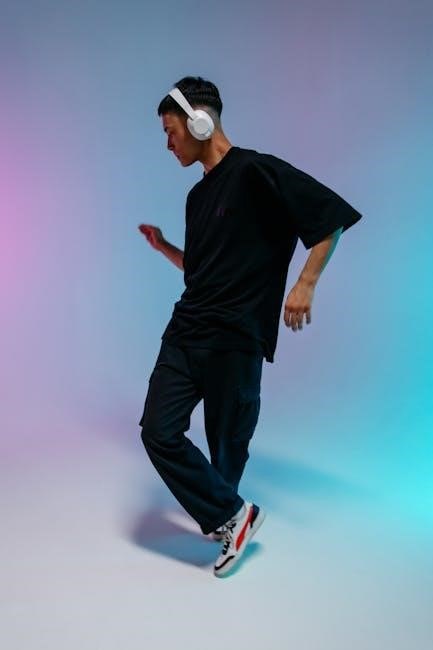
music and movement activities for preschoolers lesson plans pdf
Music and movement activities introduce preschoolers to rhythm and coordination, using
- fun games
and exercises to develop skills, with many resources available in PDF format for easy planning and implementation online.
Benefits of Music and Movement for Preschoolers
Music and movement activities have numerous benefits for preschoolers, including improved coordination and balance, enhanced cognitive skills, and better social skills. These activities also promote emotional intelligence, self-expression, and self-confidence. By participating in music and movement activities, preschoolers can develop their fine and gross motor skills, hand-eye coordination, and overall physical fitness. Additionally, music and movement activities can help preschoolers develop their language skills, memory, and concentration. The benefits of music and movement activities for preschoolers are well-documented, and many educators and childcare professionals recommend incorporating these activities into daily lesson plans. With the help of music and movement activities, preschoolers can develop a strong foundation for future academic success and a lifelong love of learning. Music and movement activities are essential for preschoolers’ overall development, and their benefits can be seen in many areas of their lives. Music and movement activities can be adapted to suit different ages and abilities, making them accessible to all preschoolers.

Types of Music and Movement Activities
Music and movement activities include singing, dancing, and playing instruments, with various types such as action songs and rhythmic games online.
Examples of Music and Movement Activities
Examples of music and movement activities include Simon Says Dance, Obstacle Course, and Musical Chairs, which promote physical activity and coordination. Other activities like Freeze Dance and Body Parts Dancing encourage creativity and self-expression. These games and activities can be adapted to suit different ages and abilities, making them accessible to all preschoolers. Music and movement activities can also be themed around popular children’s songs and nursery rhymes, making them more engaging and fun. The use of props and instruments, such as shakers and rhythm sticks, can add an extra layer of excitement and learning to these activities. By incorporating music and movement into daily routines, preschoolers can develop essential skills, including gross motor skills, balance, and coordination, while also fostering a love of music and physical activity. These activities can be used in a variety of settings, including classrooms, playgrounds, and home environments.

Lesson Plan Ideas for Music and Movement
Lesson plans incorporate music and movement, using playlists and floor space to engage preschoolers in fun activities, with online resources available for easy planning and implementation every day.
Materials Needed for Music and Movement Activities
Music and movement activities require minimal materials, including a playlist, floor space, and speakers or a music player. Additional materials like rhythm instruments, such as shakers, can enhance the experience. A computer or tablet with internet access can also be useful for accessing online resources and printable PDFs. Some activities may require specific props, like scarves or ribbons, to encourage creative movement. A clear and open space is essential for preschoolers to move around freely and safely. Teachers can also utilize everyday objects, like pots and pans, to create homemade instruments and encourage creativity. By having these basic materials, teachers can create engaging and interactive music and movement activities for their students. Online resources often provide lists of necessary materials and suggestions for adapting activities to fit specific classroom needs and budgets. This allows teachers to plan and prepare effective music and movement lessons.

Music and Movement Activities for Developing Motor Skills
Music activities help develop motor skills, coordination, and body awareness in preschoolers through fun exercises and games online daily.
Music and Movement Activities for Enhancing Thinking
Music and movement activities can enhance thinking in preschoolers by introducing them to patterns, sequences, and cause-and-effect relationships. These activities can be designed to promote critical thinking, problem-solving, and creativity. For example, music and movement games that involve following instructions, such as Simon Says, can help preschoolers develop their ability to follow directions and think critically. Additionally, activities that involve improvisation, such as free dance or movement, can encourage preschoolers to think creatively and make connections between different ideas. By incorporating music and movement activities into their daily routine, preschoolers can develop their thinking skills in a fun and engaging way. Music and movement activities can also be used to introduce preschoolers to basic concepts, such as math and literacy, in a way that is both engaging and easy to understand. This can help to lay the foundation for future academic success.

Free Music and Movement Resources
Many websites offer free music and movement resources, including printable PDFs and lesson plans, for preschoolers to learn and have fun with music and movement activities online easily.
Printable PDFs of Sheet Music for Music and Movement Activities
Printable PDFs of sheet music are available for music and movement activities, allowing teachers to easily access and print out the materials they need for their lessons. These PDFs can be found on various websites and often include a wide range of music and movement activities, such as action songs and instrumental pieces. The PDFs are usually easy to download and print, and can be used in a variety of settings, including classrooms and childcare centers. Many of the PDFs are also customizable, allowing teachers to tailor the music and movement activities to the needs and interests of their students. By using printable PDFs of sheet music, teachers can save time and effort in planning and preparing their music and movement lessons, and can focus on providing a fun and engaging experience for their students. This can help to create a positive and supportive learning environment.